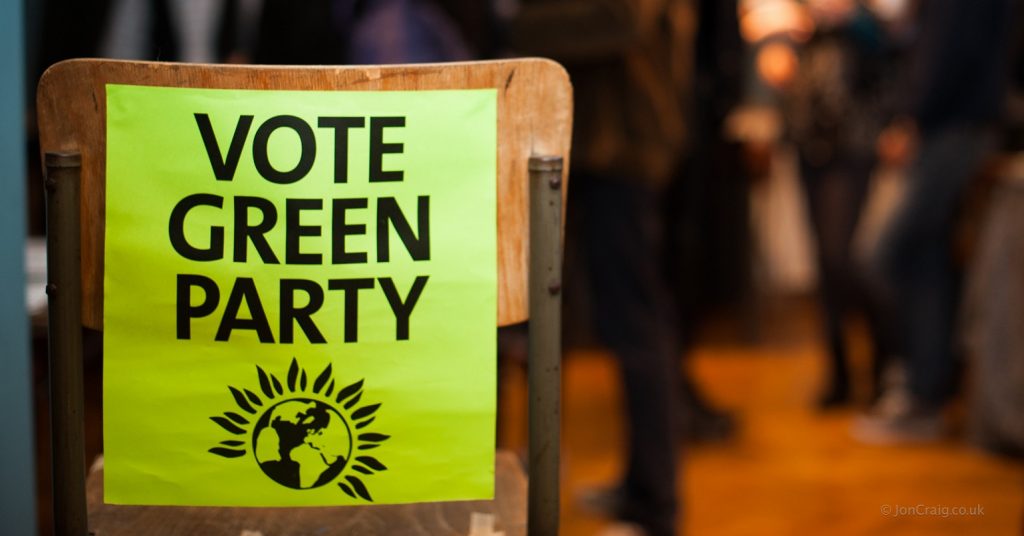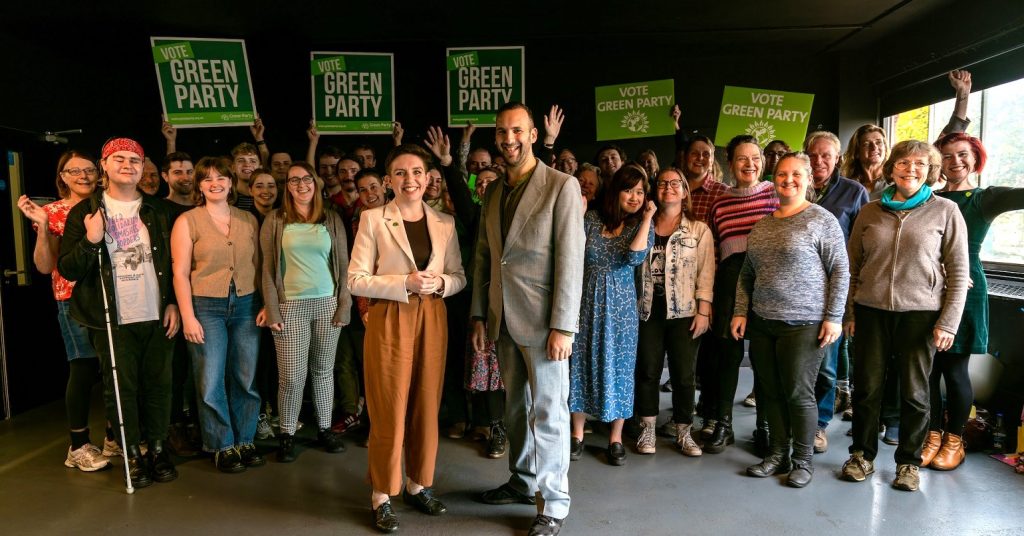The Green campaign: 8 things the party did right
Over the coming weeks and months the Green Party, like all other political parties, will go through a process of reviewing our performance in the General Election.
There are, no doubt, many lessons to be learnt – and a close look at the results will yield many suggestions of things we can do differently. I’ll be feeding into that process of course but, while the thoughts are still fresh in my head I thought I might suggest eight things that went well in this election. (Disclaimer – I am a press officer for the party, but these are just my personal opinions).
The most important statistic, which has been widely under-reported in the press, is that we averaged 4.1% in the seats in which we stood. This is the highest we’ve ever averaged, and more than double 2010’s result.
The following are eight thoughts I’ve had. I’ve certainly missed some things, and I’m sure people will challenge me over some claims, but I do think it’s time we start looking at what went right as well as what went wrong.
1) We targeted Brighton Pavilion above all other seats.
Imagine if Caroline hadn’t been elected. Years of work, many thousands of pounds and all that we’ve been working for would have been lying in the gutter. We knew we had to get Caroline re-elected, and thanks to the fantastic work of her impressive campaign team – and her ridiculously good track record as an MP- we did so with aplomb. Her Majority gives the party breathing space and a real opportunity to win more seats in 2020.
2) We broke out of Brighton and Norwich
Before this year we had never come second anywhere in a General Election. Everyone knows lots about the exceptional result in Bristol, but another equally fascinating thing happened in Sheffield, Liverpool and Manchester. With the right kind of campaigning our second places in those cities could be the building blocks of us emerging as the only alternative to Labour in key Northern Cities. Ten years ago people would have laughed at the idea of the Greens mounting a serious challenge outside of our strongholds of Brighton and Norwich – yet, with the Lib Dems collapsing, the Greens now have the chance to becoming a truly nationwide party.
(On a side note it’s worth noting that six of our ‘target seats’ were in our top nine results – suggesting that our pre-election targeting was pretty successful).
3) We talked about more than just the environment
Here’s a fact: the Green Party does better in elections when we talk about more than just the environment. This year we had three key themes: the Economy, the NHS and the Environment. We talked just as much about the economic crisis as we did about the climate crisis – and people voted for us because they recognised that. Indeed a major success of this election was our messaging around climate change. Gone was the endless catastrophising and, in its place, we talked about making people’s homes warmer, protecting communities from flooding and building an economy that works for generations to come.
4) We talked about immigration
Someone who pays more attention to the internal discussions within the Green Party can probably point you to the moment when, in the last five years, we decided we were no longer going to stand by while the other parties bashed our friends and neighbours who happened to be born outside of the UK. I’m inclined to think that, much like with our successes in Brighton, Keith Taylor MEP laid the foundations for this breakthrough when he spoke at Green Party Conference in 2013 and said:
“We stand side by side with migrants facing demonisation by the government and persecution by the press. That is our position Conference, and we will not shrink from making it known.”
That position – so well-articulated by Natalie in the second leaders’ debate – no doubt made us stand out from the other parties and won us votes.
5) We did very well in local elections – despite it being a General Election year
Usually General Election years prove to be very difficult for us in council elections, but not this year. Aside from a disappointing result in Brighton we had a very good day in local elections. We had a net gain of four seats, and are now represented on seven new councils from Bournemouth to Warwick.
6) We had top quality online and offline materials
It might seem like a small thing but the quality of our materials in this election was much much better than anything I’ve seen from the party before. The freepost was clear, concise and professional looking. Our shareable graphics were fantastic and the party’s branding was far more consistent that ever before.
Similarly the ‘Changing the Tune’ broadcast broke us out of our usual spheres and showed us to be willing to take risks – a gamble that worked.
7) We had more than one person in the media
Things didn’t always go smoothly for the party in the media – and as a press officer I’m certainly willing to take some of the blame for that. But let’s not forget that the Green Party did achieve far more coverage than ever before and – crucially – we were able to share media appearances between a number of excellent spokespeople. Caroline Lucas was able to both concentrate on Brighton and appear on key shows. Natalie Bennett did hundreds of excellent interviews, on every imaginable subject. Amelia Womack made her first appearances on national TV, and won well-deserved praise. Other spokespeople, from Darren Hall to Jillian Creasy and Andy Cooper did brilliantly on national TV shows that previously would only have accepted our leader.
8) The Young Greens
So here’s an uplifting thought: there are more members of the Young Greens than there were members of the entire party in 2010. The best thing about this: they’re quite a normal bunch and they’re organised.
When I was first involved in the Young Greens everyone was basically like me (but maybe a bit cooler): young, keen political nerds. Don’t get me wrong, there are still quite a lot of excellent nerds in the Young Greens – but the vast majority of their membership is made up of ordinary young people who are sick and tired of business-as-usual politics. The fact that so many people are lining up to for the next Young Greens internal elections this year shows just how much strength, depth and diversity this party will have in the future.
So we did eight things right. But we still have much to learn. Let’s not pretend that 2015 was the breakthrough year we’d dreamed of – it wasn’t. But, in the face of an ostensibly left-wing Labour party, we did far more than held our own.
The next five years are crucial. We need to hit the ground running with the London Elections, build on our presence in key Northern cities and ensure that the diversity of the party is better represented at the top. We also need to continue to be at the cutting edge of politics- that means making our policy process slicker and using digital tools to engage more members than ever.
But if we’re to do one thing between now and 2020 it is that we must show what a real, credible alternative looks like. With Labour and the Lib Dems in (potentially terminal) decline it is our duty to stand up for those left behind by the endless neoliberal economic malaise inflicted on us by the Tories.





We need to focus more on the message of co-operation rather than competition and identify to the electorate the real benefits of building social, political and economic change from the grass roots up, so that we take back control from the big corporations. The electorate at large is still too afraid of a party that is against the mantra of “Economic Growth at all costs”. They don’t understand what it means and need to see practical examples of how it can work.
I’m a big fan of the Pirate Party and the idea of a crowdsourced manifesto. Maybe we should speak to them about how we can update our processes? We can sell democracy as a party but we can open it up further digitally to members who can not attend conference.
Interesting article but, you completely ignored Wales…. We saw Pippa Bartolloti on the Welsh leaders debate and heard her on BBC Radio Wales. We need to gear up for the Welsh Assembly elections next year and that is well before 2020.
Miliband’s beigefesto was tokenisticly left wing at best. Only the Greens, not the SNP, had serious policy commitments to Socialist values like public ownership of our railways and universal welfare.
The Greens need to work on reaching the underclass and housing estates, and moving beyond being a party of nice educated studenty types. Talk only of trees and green spaces switches them off, talk about cuts and welfare ‘reform’ and they hear. Labour has an identity crisis, Lib Dems are a discredited irrelevance, the gate is open for Greens to become the voice of the left behind, and the radically progressive. Harness this, build on those 2nd places, and don’t let the all the disaffected vote be snatched by that bunch of vacvuous rhetorical clowns UKIP.
“We also need to continue to be at the cutting edge of politics- that means making our policy process slicker and using digital tools to engage more members than ever.” This is precisely where the greens need a massive rethink, if you want to become a party growing on a long term basis as opposed to just a surge, there needs to be a recognition that the ‘cutting edge’ of politics is not slick policy processes and digital tools.
The cutting edge of politics are the estate occupations in London and striking unions across the country – this is where the greens should be throwing their weight and attempting to become the party of social movements labour never were.
spot on mate,indeed greens need to be where the real battles lie,the greens need to become the party of social movements,but not a vanguard type of thing.
It is not primarily slick digitial messaging, it is mainly knocking on every door at least three times and doing hundreds of pieces of casework. That is is hugely primary reason we elected nine Green councillors in Lancaster. We would have got none without